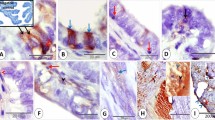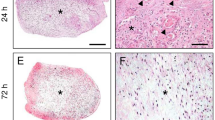Abstract
ONLY one type of cell is to be found in the uterine glands. Some of these cells may be ciliated, but are otherwise like the non-ciliated cells. In the proliferative and premenstrual phases (b), the normal constituents of these cells are mitochondria (M), Golgi apparatus (GA), fat (F) and glycogen (G). No formed secretions otherwise are found. Throughout the entire intermenstrual period, the Golgi apparatus remains juxta-nuclear and confined, but at menstruation (a), in the deeper parts of the glands, which are not broken down, a diffuse apparently secretory phase begins (V), closely resembling the secretion phases of such glands as those of the epididymis or pancreas islet cells. The surviving postmenstrual uterine gland cells have a clear cytoplasm and small juxta-nuclear Golgi apparatus. Thus, except just at menstruation, no satisfactory evidence for secretion by uterine glands during the normal intermenstrual phases could be found. There is, as has been mentioned, extensive storage of fat (premenstrual) and glycogen, and the lumen of the gland often shows a material which stains well in muchæmatein and mucicarmine, whatever value can be attached to these methods.
This is a preview of subscription content, access via your institution
Access options
Subscribe to this journal
Receive 51 print issues and online access
$199.00 per year
only $3.90 per issue
Buy this article
- Purchase on Springer Link
- Instant access to full article PDF
Prices may be subject to local taxes which are calculated during checkout
Similar content being viewed by others
Author information
Authors and Affiliations
Rights and permissions
About this article
Cite this article
GATENBY, J., AYKROYD, O. Cytology of the Human Uterine Gland Cell. Nature 144, 331–332 (1939). https://doi.org/10.1038/144331b0
Issue Date:
DOI: https://doi.org/10.1038/144331b0
Comments
By submitting a comment you agree to abide by our Terms and Community Guidelines. If you find something abusive or that does not comply with our terms or guidelines please flag it as inappropriate.



